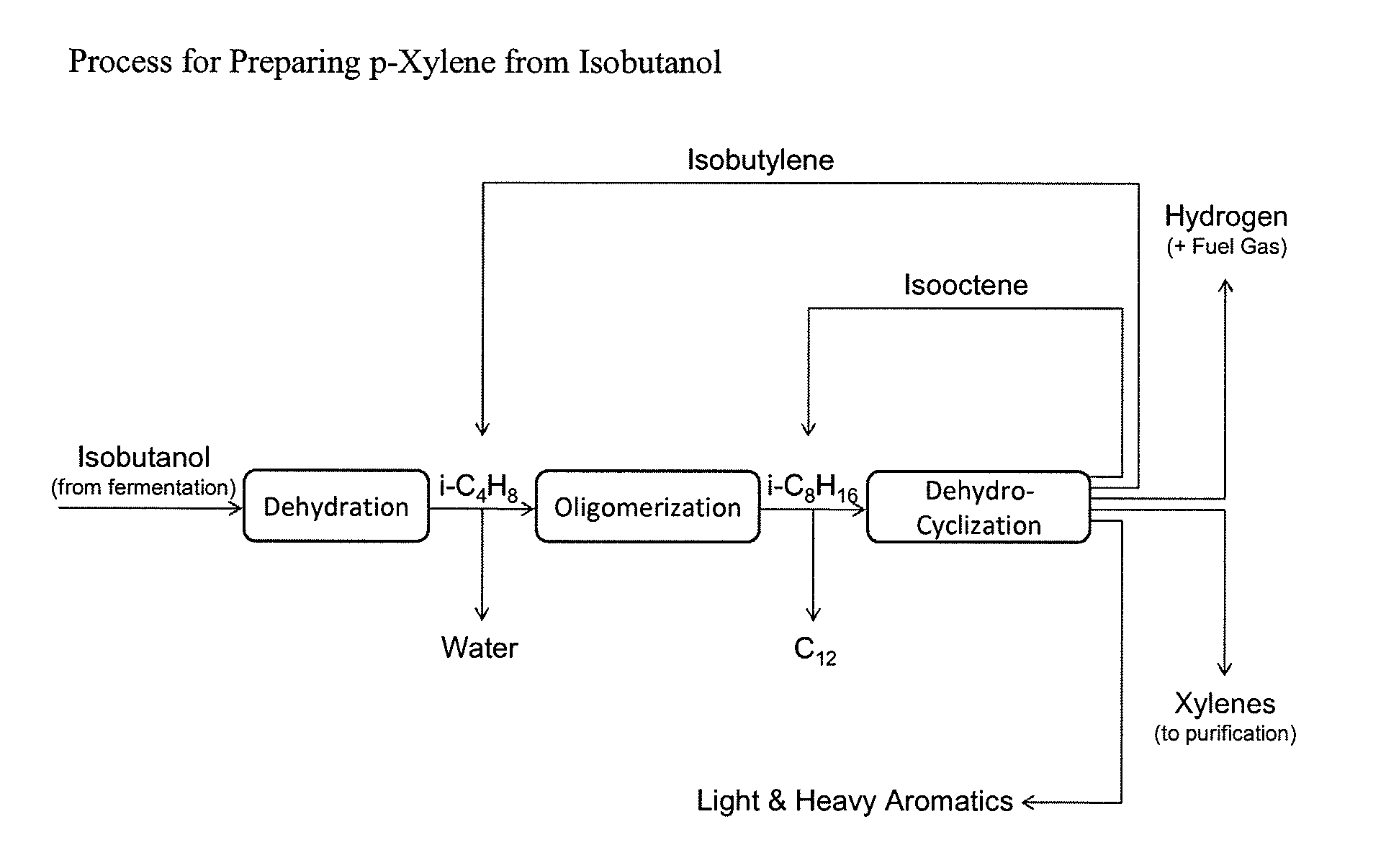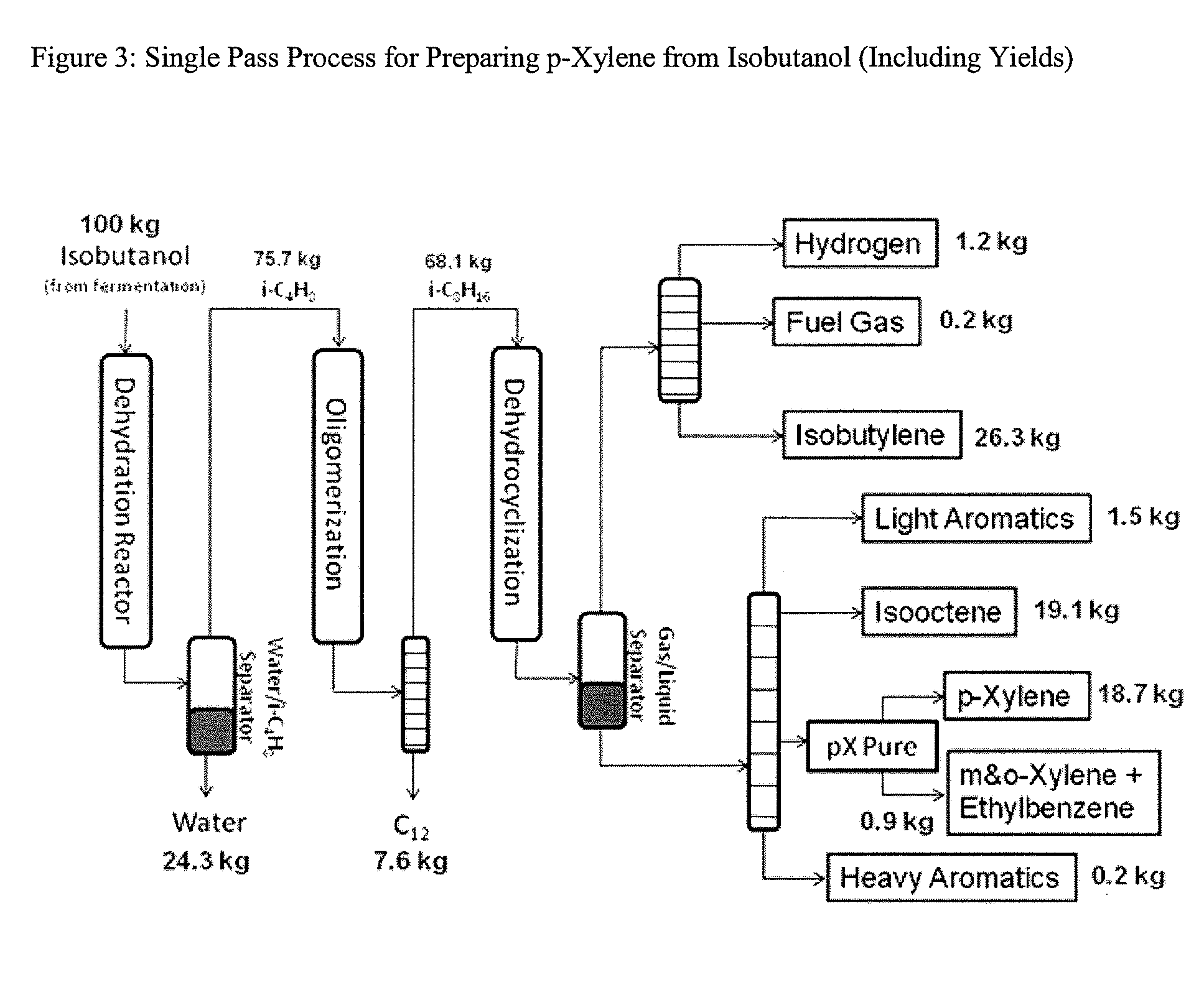Integrated Process to Selectively Convert Renewable Isobutanol to P-Xylene
a technology of p-xylene and isobutanol, which is applied in the direction of hydrocarbon preparation catalysts, hydrocarbon from oxygen organic compounds, chemical production, etc., can solve the problems of fostering over-dependence on unreliable petroleum supplies from politically unstable, complex and expensive conventional processes for producing high-purity p-xylene,
- Summary
- Abstract
- Description
- Claims
- Application Information
AI Technical Summary
Benefits of technology
Problems solved by technology
Method used
Image
Examples
example 1
[0113]An overnight culture was started in a 250 mL Erlenmeyer flask with microorganism from a freezer stock (e.g., Escherichia coli modified to produce isobutanol, e.g., the organism described in U.S. Ser. No. 12 / 263,436) with a 40 mL volume of modified M9 medium consisting of 85 g / L glucose, 20 g / L yeast extract, 20 μM ferric citrate, 5.72 mg / L H3BO3, 3.62 mg / L MnCl2.4H2O, 0.444 mg / L ZnSO4.7H2O, 0.78 mg / L Na2MnO4.2H2O, 0.158 mg / L CuSO4.5H2O, 0.0988 mg / L CoCl2.6H2O, 6.0 g / L NaHPO4, 3.0 g / L KH2PO4, 0.5 g / L NaCl, 2.0 g / L NH4Cl, 0.0444 g / L MgSO4, and 0.00481 g / L CaCl2 and at a culture OD600 of 0.02 to 0.05. The starter culture was grown for approximately 14 hrs in a 30° C. shaker at 250 rpm. Some of the starter culture was then transferred to a 400 mL DasGip fermentor vessel containing about 200 mL of modified M9 medium to achieve an initial culture OD600 of about 0.1. The vessel was attached to a computer control system to monitor and control the fermentation to a pH of 6.5 (by approp...
example 2
[0114]GEVO1780 is a modified bacterial biocatalyst (described in U.S. Publ. No. 2009 / 0226990) that contains genes on two plasmids which encode a pathway of enzymes that convert pyruvate into isobutanol. When the biocatalyst GEVO1780 was contacted with glucose in a medium suitable for growth of the biocatalyst, at about 30° C., the biocatalyst produced isobutanol from the glucose. An overnight starter culture was started in a 250 mL Erlenmeyer flask with GEVO1780 cells from a freezer stock with a 40 mL volume of modified M9 medium consisting of 85 g / L glucose, 20 g / L yeast extract, 20 μM ferric citrate, 5.72 mg / L H3BO3, 3.62 mg / L MnCl2.4H2O, 0.444 mg / L ZnSO4.7H2O, 0.78 mg / L Na2MnO4.2H2O, 0.158 mg / L CuSO4.5H2O, 0.0988 mg / L CoCl2.6H2O, NaHPO4 6.0 g / L, KH2PO4 3.0 g / L, NaCl 0.5 g / L, NH4Cl 2.0 g / L, MgSO4 0.0444 g / L and CaCl2 0.00481 g / L and at a culture OD600 of 0.02 to 0.05. The starter culture was grown for approximately 14 hrs in a 30° C. shaker at 250 rpm. Some of the starter culture ...
example 3
[0117]Dry isobutanol (−1. Primarily isobutylene and water were produced in the reactor, and were separated in a gas-liquid separator at 20° C.; the water had 99.8%. GC-FID analysis of the gas phase effluent indicated it was 95% isobutylene, 3.5% 2-butene (cis and trans) and 1.5% 1-butene.
PUM
| Property | Measurement | Unit |
|---|---|---|
| Temperature | aaaaa | aaaaa |
| Fraction | aaaaa | aaaaa |
| Fraction | aaaaa | aaaaa |
Abstract
Description
Claims
Application Information
 Login to View More
Login to View More - R&D
- Intellectual Property
- Life Sciences
- Materials
- Tech Scout
- Unparalleled Data Quality
- Higher Quality Content
- 60% Fewer Hallucinations
Browse by: Latest US Patents, China's latest patents, Technical Efficacy Thesaurus, Application Domain, Technology Topic, Popular Technical Reports.
© 2025 PatSnap. All rights reserved.Legal|Privacy policy|Modern Slavery Act Transparency Statement|Sitemap|About US| Contact US: help@patsnap.com



